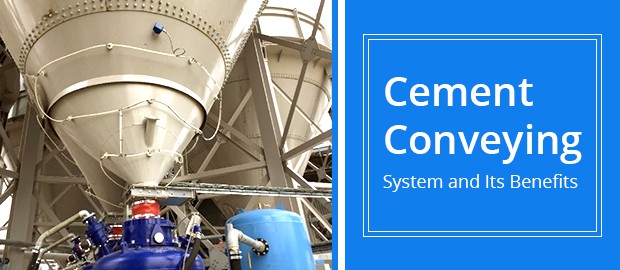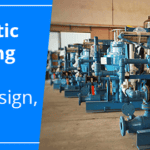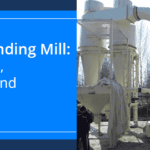The growth trajectory in the cement industry has seen a steady rise over the years, thanks to the increase in infrastructure projects. From private sector and government-led housing projects to building roads, highways, bridges and ports, all of these depend on the cement industry to provide high-quality materials at a quick turnaround.
To achieve faster results, cement manufacturers need to invest in a modern, reliable and safe bulk material handling system that helps streamline their manufacturing process. Here, partnering with an experienced cement conveyor manufacturer is mission-critical to the success of your business. Also, a custom-designed cement handling system will help simplify the transport of different abrasive products such as cement or pre-mixed cement.
Ready to Optimize Your Cement Handling? Lets start today
A] Methods of Cement Conveying
1. Mechanical Cement Conveying System
Mechanical conveyors offer uninterrupted transport of highly abrasive bulk materials such as cement and are designed to withstand tough conditions while operating reliably. Common mechanical conveyors include pipe conveyors, drag chain conveyors, in-plant belt conveyors and overland conveyors. When choosing an optimal mechanical conveying equipment, you need to consider the application needs, indoor/outdoor installation and the bulk material (dry or sticky) that needs to be conveyed. However, compared to the pneumatic conveying system, longer mechanical systems tend to consume a lot of energy, which can increase your OPEX.
2. Pneumatic Cement Conveying Systems
Understanding the different conveying methods is important when it comes to moving abrasive materials such as cement. The two pneumatic conveying system includes dilute-phase and dense-phase.
- Dilute-Phase Conveying: This method uses an air stream to suspend the cement, which ensures that the cement powder remains completely homogeneous during the mixing process. Dilute phase conveying requires much more energy to provide high volumes of conveying air and the average velocity is in the range of >100ft/sec, which results in low efficiency and high energy & maintenance cost.
- Dense-Phase (Moving Bed Conveying): Dense phase conveying uses a combination of low velocity and high pressure to move the cement through the pipe. The velocity in a moving bed-conveying system is in the range of 10-30ft/sec. The moving bed method greatly reduces pipe wear and provides energy savings. For dense-phase conveying, carbon steel pipe and wear-resistant (e.g. basalt lined) bends are used. These are ideal for long distance high capacity conveying.
- Dense-Phase (Slug Flow Conveying): This cement dense phase pneumatic conveying offers maximum energy savings and low maintenance cost. The velocity in a slug flow conveying system is in the range of 3-10ft/sec. It offers the lowest overall cost for cement & building materials conveying and has a longer pipeline life.
B] Types of Cement Handled
- Mortar Cement: Cement conveyors can handle mortar cement used to bind building blocks such as bricks, stones, and masonry units. Mortar cement is also used to seal uneven gaps between building blocks and can include asphalt, pitch or soft mud/clay.
- Portland Cement (OPC): Made from heating limestone and other types of clay materials, this is a common type of cement that is widely used. OPC can be found in mortar, concrete, non-speciality grout, and stucco.
- Concrete Cement: Concrete cement is a composite material made from a mixture of Portland cement and water, which is then mixed with aggregates such as sand, coarse gravel, or crushed rocks (granite or limestone) to make an impenetrable rock-like mass.
- Asphalt Cement: Cement conveyors can also handle asphalt cement (bitumen), which is a black, sticky, highly viscous liquid (semi-solid form) of petroleum. It is commonly used in the construction of roads, sealing flat roofs, etc.
Ready to Optimize Your Cement Handling? Lets start today
#Different Types of Cement Handling Products
- Bucket Elevator Chain
- Clinker Conveyors
- Cement Conveyor with Rollers and Wheels
- Scraper Chains
- Drag Chain Conveyor
- Stacker Reclaimer Chains
- Apron Pan Conveyors Systems
- Conveyor Sprockets
C] Advantages of Pneumatic Cement Conveying System
- Maximum Efficiency and Quality Products: Pneumatic conveyors offer a faster transfer of materials, thereby maximising efficiency and providing optimal performance. The enclosed design prevents product contamination, thereby ensuring that the quality of the transported materials is not compromised during the process. Plus, it offers a dust-free environment, thereby protecting the health of the workers and the environment at large. Preventing the dust from escaping during the material transfer also prevents the risk of explosion.
- A Cleaner Method to Transfer Materials: Pneumatic cement conveyors eliminate the risk of spillage, thanks to their enclosed designed and closed pipelines. The seal created by the enclosed piping system keeps the material contained, thereby preventing potentially dangerous spills. This can be especially useful when transferring hazardous materials and can help protect your workforce.
- Design Flexibility: It offers complete flexibility in terms of design and can be adapted to utilize the available floor space through flexible pipeline layouts. In case of any process change or expansion, a pneumatic system saves you the expense of adding new equipment through a simple diverter valve and pipes rather than purchasing an entirely new mechanical system.
- Hygienic: With crevice-free surface designs to ensure powders and material does not get trapped, powder transfer systems help reduce the risk of product contamination. It also eliminates exterior contaminants, thereby ensuring the facility and equipment remains cleaner as well. Additionally, the powder transfer equipment comes with stainless steel construction and FDA compliant seals. Plus, piping can be CIP cleaned and dried.
- Less Maintenance: Simple structure and fewer mechanical moving parts of the pneumatic cement conveying system ensures less wear and tear. This reduces the maintenance cost considerably. Each part of the system is repairable, so if a single part fails, you wouldn’t need to replace the entire system. Fewer moving parts also greatly reduces the chances of mechanical failures, which ensures that the production flow is not interrupted and the process is working smoothly across all levels.
- Simple Routing: When it comes to bulk material handling, pneumatic conveying for the cement industry helps simplify the routing of different transfer paths throughout the plant. Most conveying lines consist of simple pipes that can flow in both horizontal and vertical directions, which makes material routing easier. Also, unlike the straight route required by mechanical conveyors, conveying lines of a pneumatic system can be built to avoid or go around obstructions. What’s more, you require minimum floor space as the conveying line can be attached to an existing structure, column, or rafter. This eliminates the need for constructing special foundation or support frames.
Ready to Optimize Your Cement Handling? Lets start today
#Macawber Cement Conveying System: What We Offer
At Macawber Engineering, we provide turnkey solutions to all major cement manufacturers, effectively meeting the growing demands for innovative material handling requirements of the infrastructure industry. We offer mechanical and pneumatic cement handling systems that can be customised to deliver the required function. They are designed with unique technology and offers enclosed conveying lines that provide smooth, uninterrupted operations, irrespective of the weather conditions. The enclosed conveying also makes the entire process dust-free and environment-friendly.
We understand that cost is a determining factor when it comes to the decision of investing in a capital equipment system. As such, we ensure to provide the best cement conveying system that helps boost the material handling capability, thereby providing a high return on investment.
Our proven technologies for handling cement and other building products offer the lowest possible operating cost i.e. energy and maintenance costs. For short or long conveying distances, the Variflo and Macpump can convey cement at high tonnage rates with low operating costs.
Whereas, our cement conveyor (Cementveyor) system has been designed for conveying moderate tonnage rates at distances below 1000ft and provides very efficient use of conveying air. This system provides the following benefits:
- Simplified equipment configuration and operations.
- Efficient long distance conveying through the use of smaller pipe size.
- Reduce equipment price by minimum 15%.
- Highly-efficient and reliable conveying of cement and other abrasive materials.
We also have proven solutions for feeding, injection and dosing at controlled rates.
Connect with us for more information!



